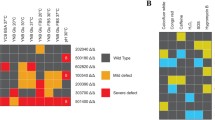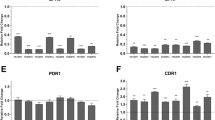Abstract
Candida albicans is a common cause of morbidity in hospitalized and immunosuppressed patients. There are still many unknown genes involved in the virulence of C. albicans. The present study aims to examine the effect of TOP2 gene in candidal virulence, including hyphal growth, phospholipase and proteinase activity. Targeted gene disruption of both TOP2 alleles in a wild-type strain of C. albicans produced hyphae more efficiently. TOP2 disruption also increased phospholipase and proteinase activities, and enhanced virulence as assessed by host tissue colonization in systemic infection model. The result of reverse transcription PCR displayed that PLB1 and SAP4 expressions of top2 mutants was significantly upregulated when compared with the isogenic parental strain. Together, these results indicated that TOP2 gene was involved in candidal pathogenicity, and the major reasons for the comparatively high virulence of null mutants were the higher capacity to produce hyphae and the increased phospholipase and proteinase activities, at least in part.




Similar content being viewed by others
References
Ellis M (2002) Invasive fungal infections: evolving challenges for diagnosis and therapeutics. Mol Immunol 38:947–957
Nailis H, Kucharíková S, Řičicová M, Dijck PV, Deforce D, Nelis H, Coenye T (2010) Real- time PCR expression profiling of genesencoding potential virulence factors in Candida albicans biofilms: identification of model-dependent and -independent gene expression. BMC Microbiol 10:114–125
Calderone RA, Fonzi WA (2001) Virulence factors of Candida albicans. Trends Microbiol 9:327–335
Georgopapadakou NH, Walsh TJ (1996) Antifungal agents: chemotherapeutic targets and immunologic strategies. Antimicrob Agents Chemother 40:279–291
Ernst JF (2000) Transcription factors in Candida albicans-environmental control of morphogenesis. Microbiology 146:1763–1774
Lo HJ, Köhler JR, DiDomenico B, Loebenberg D, Cacciapuoti A, Fink GR (1997) Nonfilamentous C. albicans mutants are avirulent. Cell 90:939–949
Songer JG (1997) Bacterial phospholipases and their role in virulence. Trends Microbiol 5:156–161
Schmiel DH, Miller VL (1999) Bacterial phospholipases and pathogenesis. Microbes Infect 1:1103–1112
Monod M (1994) Multiplicity of genes encoding secreted aspartic proteinases in Candida species. Mol Microbiol 13:357–368
Watt PM, Hickson ID (1994) Structure and function of type II DNA topoisomerases. Biochem J 303:681–695
Beatrice AK, Sandhiya P, Mark F (1997) Molecular cloning and expression of the Candida albicans TOP2 gene allows study of fungal DNA topoisomerase II inhibitors in yeast. Biochem J 324:329–339
Zheng H, Jiang YY, Wang Y, Gao PH, Yan L, Jiang LH, Ji H, Cao YB (2010) TOP2 gene disruption reduces drug susceptibility by increasing intracellular ergosterol biosynthesis in Candida albicans. J Med Microbiol 59:797–803
Fekete FK, Gyure L, Lenkey B (2000) Changes of virulence factors accompanying the phenomenon of induced fluconazole resistance in Candida albicans. Mycoses 43(7–8):273–279
Lee KL, Buckley HR, Campbell C (1975) An amino acid liquid synthetic medium for the development of mycelial and yeast forms of Candida albicans. Sabouraudia 13:148–153
Liu H, Köhler J, Fink GR (1994) Suppression of hyphal formation in Candida albicans by mutation of a STE12 homolog. Science 266:1723–1726
Price MF, Wilkinson ID, Gentry LO (1982) Plate method for detection of phospholipase activity in Candida albicans. Sabouraudia 20:7–14
Mullick A, Elias M, Picard S, Bourget L, Jovcevski O, Gauthier S, Tuite A, Harakidas P, Bihun C, Massie B, Gros P (2004) Dysregulated inflammatory response to Candida albicans in a C5-deficient mouse strain. Infect Immun 72:5868–5876
Marianne D, de Hoogt RA, Froyen G, Odds FC, Simons F, Contreras R, Luyten WH (2000) Single allele knock-out of Candida albicans CGT1 leads to unexpected resistance to hygromycin B and elevated temperature. Microbiology 146:353–365
Steven DL, Ashraf SI, Yue F, Anjni K, Chad J, John V, William F, Fariba M, Shigeru N, Yoshinori N, Mahmoud AG (1998) Cloning and disruption of caPLB1, a phospholipase B gene involved in the pathogenicity of Candida albicans. J Bio Chem 273:26078–26086
Gale CA, Bendel CM, McClellan M, Hauser M, Becker JM, Berman J, Hostetter MK (1998) Linkage of adhesion, filamentous growth, and virulence in Candida albicans to a single gene, INT1. Science 279:1355–1358
Brand A, MacCallum DM, Brown AJ, Gow NA, Odds FC (2004) Ectopic expression of URA3 can influence the virulence phenotypes and proteome of Candida albicans but can be overcome by targeted reintegration of URA3 at the RPS10 locus. Eukaryot Cell 3:900–909
Hoover CI, Jantapour MJ, Newport G, Agabian N, Fisher SJ (1998) Cloning and regulated expression of the Candida albicans phospholipase B (PLB1) gene. FEMS Microbiol Lett 167:163–169
Cutler JE (1991) Putative virulence factors of Candida albicans. Annu Rev Microbiol 45:187–218
Alistair JP, Neil Brown, Gow AR (1999) Regulatory networks controlling Candida albicans morphogenesis. Trends Microbiol 7:333–338
Stephanie T, Ganchimeg I, Audrey B, Marianne K (2006) Inactivation of the phospholipase B gene PLB5 in wild-type Candida albicans reduces cell-associated phospholipase A2 activity and attenuates virulence. Int J Med Microbiol 296:405–420
Acknowledgments
This study was supported by the National Natural Science Foundation of China (81101298), Special Project for Central Institution of Higher Learning Scientific Research (11D10518). The authors thank YY Jiang (Second Military Medical University, Shanghai, China) for kindly providing some C. albicans strains used in the study.
Author information
Authors and Affiliations
Corresponding author
Rights and permissions
About this article
Cite this article
Zheng, H., Yu, Ys. TOP2 gene is involved in the pathogenicity of Candida albicans . Mol Cell Biochem 364, 45–52 (2012). https://doi.org/10.1007/s11010-011-1203-9
Received:
Accepted:
Published:
Issue Date:
DOI: https://doi.org/10.1007/s11010-011-1203-9




